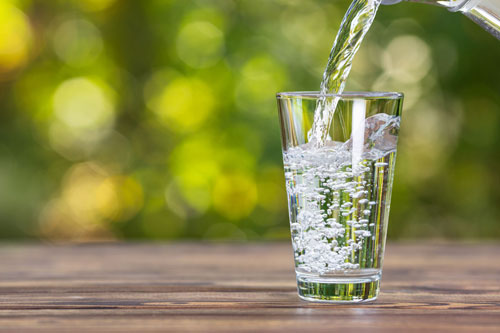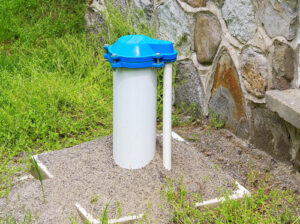Many Americans use municipal water in their homes, but over 13% of Maryland residents rely on a private well for their drinking water. Using a private well can come with benefits, but there can be challenges in keeping the water supply clean and safe to drink, particularly when dealing with a private well after flooding. Beyond the water testing that you should perform regularly, there are special steps you should take in the aftermath of a flood or severe rain to ensure the quality of your drinking water.
What Happens to a Well During a Flood?
During a flood, there is a high risk that your well could be contaminated. Flood water can carry along with it large debris that may loosen hardware, distort the casing, or damage well construction materials. If there is excessive sediment present in the water, it can compromise the components of your well pump. Additionally, if your well is not properly capped, flood water and debris can enter the well and cause contamination. This ground water can carry with it bacteria, chemicals and other hazardous substances that should not be consumed. The wells at the highest risk of contamination are those less than 50 feet deep or over 10 years old. Wells that are already compromised can even collapse during a flood. Regular maintenance and examination of the structure of a private well is important.
Checking Your Well After Flooding
If you have a well that was drilled, driven or bored, it can often be the best choice to contact a contractor to thoroughly disinfect the well and ensure your safety. If your pump stopped running, you should turn on the well pump after flooding with extreme caution, as there is a serious risk of electrical shock that would harm you or do damage to your pump and well. Sediment from the water can also be inside the pump and lead to permanent damage. You must thoroughly clean all elements of the pump, including gears and valves inside, and allow them to fully dry before use. Never drink or wash using the water from your well before disinfection.
After flooding, it’s important to sample and test the well water. Know that it might be months before your water will be reliably safe again, as waste water from septic tanks and chemicals kicked up during the flood can continue to contaminate ground water even after your private well has been cleaned and tested. Therefore, it is recommended that you continue testing in the following months to ensure it is completely safe to use and drink.
How Can You Disinfect a Well That Was Flooded?
Many people choose to outsource this intensive task to a professional, but you can do it on your own. If you notice any damage to wiring, you should call a professional before you start disinfecting. Gather a gallon of non-scented liquid bleach, sturdy rubber gloves, eye protection, old clothes that can be damaged and a funnel.
- Does the water in the well look cloudy or muddy? First, you should run water from a hose attached to an outdoor spigot until it is clear again and contains no visible sediment.
- Depending on the type of well that you have, there may be a different way to add the bleach to the well. If there is an air vent or plug that can be removed, that is where you will pour the bleach. If you have a bored or dug well, the cover should be lifted off to easily add the bleach to the well.
- If needed, use the funnel to help carefully pour the bleach into the well.
- Once you add the bleach, use water from your outdoor hose and run the water into the well until you can detect a chlorine scent coming from the water in the hose. Turn off the hose.
- Head back inside of your home and turn on all of the cold water faucets. Once you notice the chlorine smell, you can shut the faucets off again. Do the same on the outside of the house. If you already have a water filtration solution inside of your home, make sure it is bypassed before doing this step.
- Wait 24 hours before opening the faucets again. In order for the disinfection process to work, you must make sure that you do not drink, bathe, wash or cook using any of the water at this time. The levels of chlorine will be very high.
- After you clear the waiting period, turn on the outdoor hose again and carefully start to drain the water. The stream of water needs only to be pencil thin. Avoid putting the water near plants or streams that might absorb this chlorine-rich water. Again, run the water until the chlorine scent goes away. This may take an additional 24 hours to occur. Turn the water off again..
- Now, your system should be safe to test again and use. You should have it tested again about 7-10 days after you finish the disinfection process.
How Can You Make Sure Your Well Water Is Safe?
For many of our customers with bad well water who are uncertain about its safety in the aftermath of local flooding, the WaterMax® System paired with an ultraviolet filter is a great solution. This innovative and fully customizable device removes sediment, salt, dirt and contaminants from your water supply, all while providing soft water throughout your home. The WaterMax® even includes a 25-year Manufacturer’s Limited warranty, so you can have peace of mind that your water will remain clean and healthy. You will never need to worry about the cost of bad well water again.
Make Your Well Water Safe After a Flood with Hague Quality Water of Maryland
If your family lives in Anne Arundel, Montgomery, Prince George’s, or Queen Anne’s County and you are concerned about the quality and contents of your water, we are here to help with your water improvement projects. Whether you need the Hague WaterMax® System or additional filtration beyond that, our team cares deeply about the health and safety of your family. For additional assistance, call Hague Quality Water of Maryland at (410) 757-2992.




